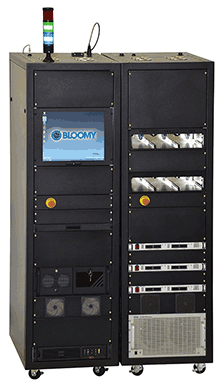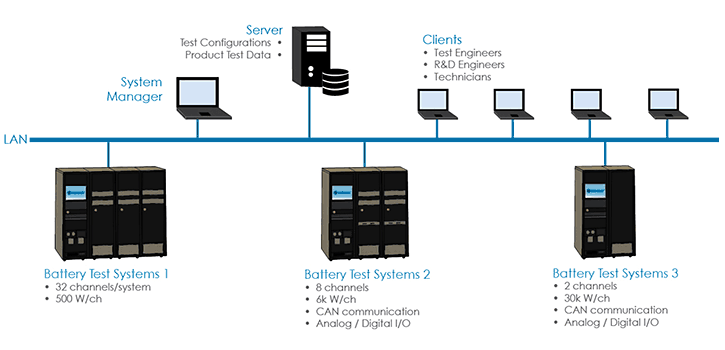 Customized battery cycling and control
Customized battery cycling and control
The Mixed-Signal Battery-Test System is an automated test platform designed to meet today’s advanced battery test requirements. The platform is ideal for testing a range of battery cells and packs, and can be used in applications such as research and design, quality control, and end-of-line manufacturing. Its distributed architecture provides a scalable solution with configurable system components to accommodate specific applications.
- Hardware resource sharing for long cycle times reduces overall system cost
- Distributed system architecture for easy system expansion
- Customizable software for user-defined monitoring, tests, alarms, and profiles
- Wide range of standard test, charge, and discharge functionality
- Reliable and easy to maintain
The Mixed Signal Battery Test System is a configurable system allowing for unique voltage, current, and channel configurations. The system features:
- Constant current, voltage, and power control
- Standard and custom charge and discharge profiles
- Load profile capture and playback
- Flexible hardware configurations: channel count, power, auxiliary IO
- Industry-leading measurement
- Battery communication protocols including CAN, I2C, SMBus
- Advanced Battery IO: analog, digital, safety
- Custom hardware fixtures and cabling for battery interfacing
The distributed system architecture allows multiple battery test systems with different configurations to be easily added to the system manager.

The platform can be customized to meet specific channel, power, and IO configurations.
| RANGE | ACCURACY | RESOLUTION | ||
|---|---|---|---|---|
| Power | 150W to 60kW | |||
| High Current Models | ||||
| Charge | Voltage | Up to 150V | 0.1% FS | 0.03% |
| Current | Up to 3000A | 0.3% FS | 0.03% | |
| Discharge | Voltage | 1.0 to 120V | 0.05% Set + 0.05% Range | 0.025% |
| Current | Up to 7200A | 0.12% Set + 0.08% Range | 0.025% | |
| High Voltage Models | ||||
| Charge | Voltage | Up to 800V | 0.1% FS | 0.03% |
| Current | Up to 300A | 0.2% FS | 0.03% | |
| Discharge | Voltage | 7.0 to 600V | 0.05% Set + 0.05% Range | 0.025% |
| Current | Up to 1800A | 0.12% Set + 0.08% Range | 0.025% | |
| Measurements | ||||
| Voltage | Full range | 0.03% | 16 to 24 bit | |
| Current | Full range | 0.1% | 16 to 24 bit | |
| Sampling Rate | Up to 20kS/s/ch for transient capture | |||
| Options | ||||
| Communications | CAN, SMBus, Serial, Modbus, I2C, custom protocols | |||
| Analog I/O | Channel and range configurable | |||
| Digital I/O | TTL, 24V logic | |||
| High isolation cell monitoring | Channel and range configurable | |||
| Temperature monitoring | Channel and range configurable | |||
| Strain gauge monitoring | Channel and range configurable | |||
| Pressure monitoring | Channel and range configurable | |||
| Internal resistance (AC, DC) | Channel and range configurable | |||
| Additional charge & discharge profiles | • Constant resistance (Amps/Volts) discharge • Taper or Pulse charge • Customized profiles | |||
| Customer defined monitoring | • Pass/Fail Alarms • OCV, CCV • SOC, SOH | |||
The system application has a customized user interface for easy system navigation. The application provides the distributed systems all necessary charge and discharge functionality and tests. Some of the major system components are:
- System Configuration: The system configuration holds all necessary hardware configuration information, software variables, IP address, etc. which is used to allow the system to operate.
- System Login: The system provides the ability for multiple user levels (operator, administrator) restrict access to certain portions of the application
- Part Selection: Allows the operator to select the test plan for the product which will be tested and configure its test details.
- Product Tests: The application executes a defined test cycle based on the configuration which could include:
- Operating Modes: Charge, Discharge Rest
- Program Step Settings: Voltage, Current, Sample Time, Step Duration
- Program Step Limits: Step time, Current, Voltage, Power, Amp-Hours
- Program Step Limit Actions: A limit action will use standard operators (>, >=, <, <=, OR, AND) to combine limits to create an action.
- Data Reporting: Real-time data is available during testing of the product. Product test results can be saved in multiple formats (TDMS, Excel, CSV)
